Depth bombs, ruthless bursts from machine guns and boundless stupidity. Five sailors were killed and sixteen injured. This is how the fratricidal attack of the Allied units on the Polish submarine ended. An incident that great history has forgotten. And who has never been properly judged.
At the beginning of November 1941, the Polish Navy took over the "S" submarine at the US Navy base in New London. This unit, despite the renovation, was completely worn out with a long service in the American fleet. In the opinion of Polish sailors, the only plus of the "new" acquisition was ... a refrigerator. The commander of the "Hawk" - that was the name of the ship - became Cpt. Bolesław Romanowski, the future Polish "ace" of the submarine war.
Routine Task
In April 1942 ORP "Jastrząb" received its first combat task:it was to participate in the cover of the PQ-15 convoy going from Reykjavik to Murmansk. The convoy consisted of 25 ships and 14 ships of direct cover. Two British heavy cruisers were active as a long-range shield team, and the support of heavy ships of the British Home Fleet and the cooperating American squadron was on standby.
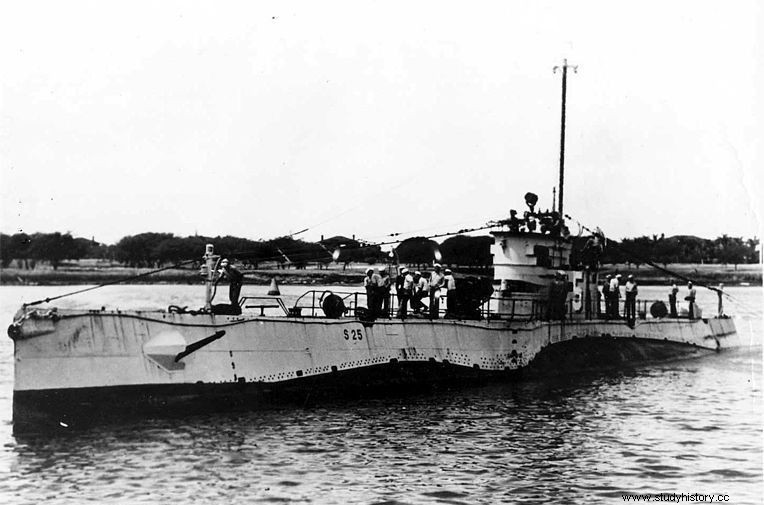
Brand new S-25 pictured in 1923 or 1924, possibly at New London base. A dozen or so years later, his only asset was to be a refrigerator.
The "Hawk" was in a group of 4 Allied submarines, whose main task was to alert allied units about the departure of German heavy ships based in the Norwegian fjords, including the supermattleship "Tirpitz". The Polish submarine patrol sector was approximately 200 miles southwest of Tromsø.
Ten on the Beaufort scale
The Polish unit went to sea on April 25. The transition to the designated position took place in very difficult conditions, in stormy weather and snowstorms. In the patrolling sector, the weather continued to be very harsh. "Hawks" began to harass, one after another, numerous failures of the ship's mechanisms .
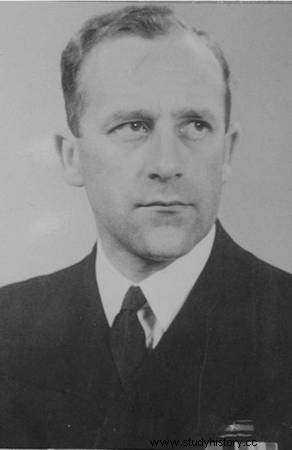
Captain Bolesław Romanowski. He was given the dubious privilege of commanding ORP "Jastrząb".
Was damaged, among others the left bow thruster, which made the ship difficult to keep at the proper depth. In this situation, the commander called the officers to a meeting. The main question was whether to continue the patrol in the current situation?
The ship's condition qualified her to discontinue operations and return to base, but officers opted to stay in the sector. Eventually, "Hawk", by the decision of the commander, remained in position.
Bad luck did not leave the crew, however. On the fifth day of the voyage, the waves broke part of the deck and, in order to avoid further damage, the Polish vessel had to descend to a greater depth. In turn, it was not possible to conduct observations and Capt. Romanowski decided that the "Hawk" would come out to the periscope depth every half an hour, so that the sea surface could be surveyed.
In such conditions, on May 2, at around 2 p.m., Polish hydroacoustics, using noise-meters, picked up the sound of a ship's propellers on the surface. After going to the periscope depth Cpt. Romanowski saw in the eyepiece the periscope of the German U-boat located only 400 m from ORP "Jastrząb"!
The tactical situation was convenient for launching torpedoes, especially since the Poles were not detected by the enemy unit. However, before the torpedo apparatuses were ready for firing, the "Hawk" - due to the malfunction of the bow rudder - suddenly plunged to a greater depth. Unfortunately, after reaching periscope depth again, the U-boat was gone.
Nobody wants to end up like "Titanic"
Meanwhile, the terrible weather conditions also took their toll on the convoy ships. More and more floating ice began to appear on its route. A collision with an iceberg in conditions of limited visibility was becoming very real, and to prevent it, the convoy's route was adjusted to move it further south.
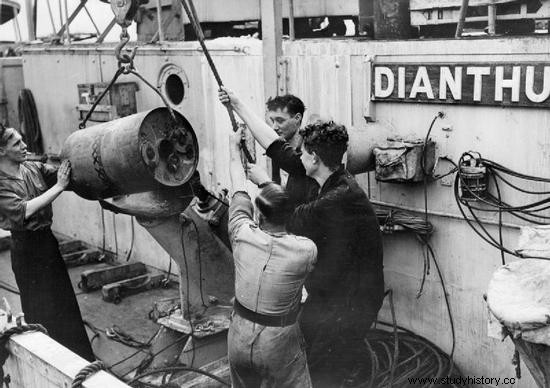
Loading of depth charges on board the HMS Dianthus corvette. It was the loads of this type that almost sent ORP "Jastrząb" to the bottom.
By a twist of fate, it now ran through the surveillance sectors of the Allied units. To make matters worse, the commanders of the escorts were not informed about the possibility of meeting their own submarines. Therefore, each detected unit was treated as an enemy U-boat .
On May 2, around 7:40 pm, the hydroacoustics of the Hawk once again caught the sound of the propellers. After going to the periscope depth, Capt. Romanowski saw two ships in the periscope glasses, which he recognized as an old American destroyer and a British minesweeper.
The "hawk" unexpectedly descended to a greater depth again and when it returned to the periscope hydroacoustics they heard a characteristic sonar "ping", i.e. the sound of sound waves reflecting off the hull. This meant that the Poles were tracked by ships on the surface and behind them. Depth bombs may fall for a while!
Our sailors had two options. They could have escaped to a greater depth and waited out the attack there, or they could emerge and give their identification marks. Since these were allied units, Capt. Romanowski decided to fire a yellow smoke candle, which was the pre-arranged signal.
At this point, the destroyer launched an attack and threw a series of depth charges. The Polish ship then accelerated and began to descend to a greater depth. Another smoke candle has been fired in the meantime. The answer was a second series of bombs. The destroyer began to move away and the minesweeper began its attack. Fortunately, the Poles managed to outmaneuver these bombs as well and there was no direct hit.

British HMS "Seagull", the minesweeper whose crew attacked the "Hawk" so vigorously
Friendly fire
Nevertheless, the damage from the near explosions was high. The light went out on the "Hawk", both engines stopped, and the cracked batteries were emitting suffocating, poisonous chlorine, which was even worse, the hull began to leak .
Romanowski therefore ordered the ship to emerge. The "Hawk" came to the surface between the minesweeper and the destroyer, both Allied escorts opened fire at it with rapid-fire cannons and machine guns.
The first to jump on the pier of the Polish ship was the English whistleblower Thomas Beard to give his identification marks in an aldis. It ended tragically for him. Died on the spot mowed by an accurate series . Cpt. Bolesław Romanowski was the second to come out on the pier. In his case, it ended up being shot in the leg.
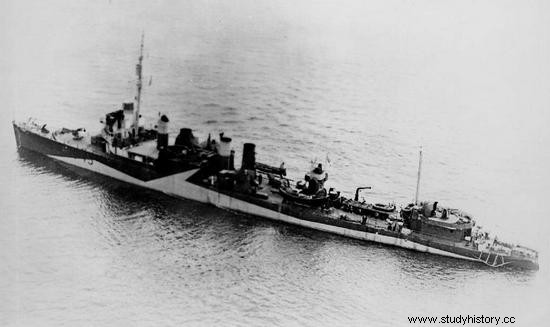
Destroyer "St. Albans ". The old and worn-out American ship serving under the Norwegian flag was the second "conqueror" of ORP "Jastrząb".
At some point, seeing that the destroyer was going to ram the Polish unit, the commander ordered to open all hatches and board the entire crew. British radio operator Martin Dowd began broadcasting his aldis the identification marks of the Polish ship in the direction of the minesweeper. This one stopped firing immediately.
Meanwhile, the destroyer positioned itself at a distance of about 50 meters from the Polish unit and opened fire again. There were many sailors on the "Hawk" pier at that moment, the real massacre of the Polish crew began . Capt. Romanowski raised the Polish flag stained with blood above his head. The destroyer stopped the fire. From his platform came the question:
- Are you German? (Are you German?)
The Polish captain replied:
- We are Polish submarine "Hawk" can’t you see "P-551" - bloody fool? (We are the Polish submarine "Hawk", can't you see the P-551 damned fools?)
The "conquerors" of the Polish ship turned out to be the Norwegian destroyer "St. Albans "and the British minesweeper HMS Seagull. They immediately began the rescue operation, evacuating the crew of ORP "Jastrząb" to their decks. The Polish ship was so badly damaged by close depth charges and artillery fire that there was practically no help for it, it was slowly sinking. Eventually, it was killed by the artillery of a minesweeper.
The losses among the crew of the "Hawk" were serious: three Poles and two British were killed on the spot , in addition, four officers, including the commander, and 12 seamen were injured.
However, there is no bad thing…
The British Admiralty set up a special commission to investigate the causes of this incident. The verdict she issued was truly Solomonic. It was established that the Polish ship sank as a result of an unfortunate coincidence , which consisted of the poor technical condition of the ship and terrible weather conditions that made it impossible to determine the actual position of the "Hawk". There was also a change of course by the convoy, which the Polish commander was not informed about.
As a result, the attack on the Polish unit was deemed justified . The commission highly appreciated the attitude of Capt. Romanowski and the crew, as well as pointed out the fact that the Allied officers did not understand the distinctive signs in the form of yellow flares, which could have prevented the tragedy.
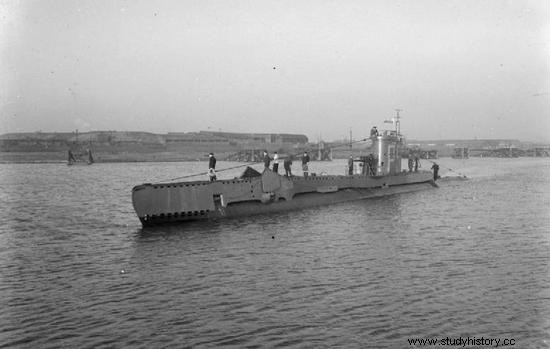
ORP Dzik in all its glory. It was this ship that the Polish Navy received in exchange for the sunken "Hawk". Its first commander was Cpt. Romanowski.
In return for the lost "Hawk", the Polish Navy received another submarine. This time it was a modern unit, a twin of the then famous "Falcon". The new ship was named ORP "Dzik", its first commander was captain Bolesław Romanowski, and the crew were seamen from the sunken ORP "Jastrząb". However, it did not restore the lives of those killed without sense to the submarines.
